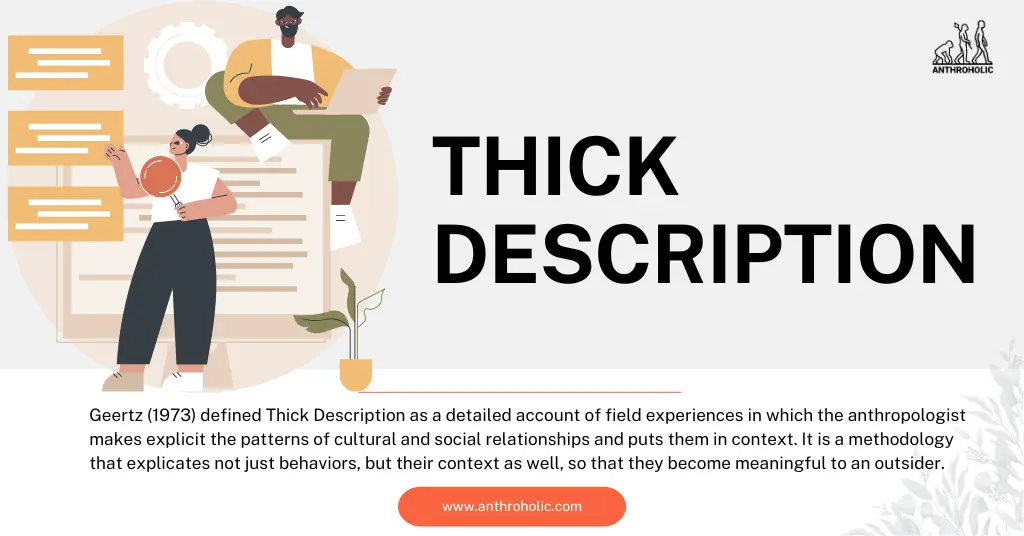AI Answer Evaluation Platform Live Now. Try Free Answer Evaluation Now
Thick Description
Thick Description is a term that has its origins in the field of ethnography and the interpretive theory of culture formulated by the anthropologist Clifford Geertz. Rooted in an approach that prioritizes the deep, textured context of human actions and behaviors, it moves beyond mere statistical data or observations to delve into the meanings, circumstances, and interpretations that shape human experiences (Geertz, 1973).

Understanding Thick Description
Definition
Geertz (1973) defined Thick Description as a detailed account of field experiences in which the anthropologist makes explicit the patterns of cultural and social relationships and puts them in context. It is a methodology that explicates not just behaviors, but their context as well, so that they become meaningful to an outsider.
Elements of Thick Description
- Detail: Involves comprehensive and exhaustive information about the event or situation.
- Context: A clear understanding of the cultural, social, and personal backdrop.
- Meaning: An understanding of the symbolism and significance of actions and behaviors.
- Interpretation: Interpretation of the observed phenomena within the context and framework of the specific culture.
Thick Description Vs Thin Description
One can better comprehend Thick Description by contrasting it with its counterpart: Thin Description.
| Thick Description | Thin Description | |
|---|---|---|
| What it is | Detailed, comprehensive, contextualized data | Basic, surface-level data |
| Depth of Data | Deep, interpretive, layered | Superficial, non-interpretive |
| Application | Anthropology, Qualitative Research | Quantitative Research, Statistics |
| Purpose | To understand culture, meaning, and context | To collect factual, statistical data |
The Application of Thick Description
Thick Description’s utility extends beyond anthropology into various disciplines, including sociology, history, psychology, and more recently, user experience (UX) research.
- Anthropology and Sociology: It’s used in ethnographic studies to interpret cultural phenomena.
- History: It provides a contextualized understanding of historical events and eras.
- Psychology: It aids in understanding human behavior within specific contexts.
- UX Research: It helps to deeply understand user behavior and their interaction with products.
Criticisms of Thick Description
Like any methodology, Thick Description has faced its share of criticisms. Some scholars argue that it may be overly subjective, dependent on the researcher’s interpretations. Others point out the possibility of losing sight of the broader social or political structures due to the intense focus on the microcosmic details of daily life.
Deepening the Discourse: The Relevance of Thick Description
The Significance of Thick Description in Research
Given the increasing emphasis on human-centered approaches in various fields, Thick Description’s relevance has never been more crucial.
- Authentic Representation: Thick Description offers an in-depth, authentic portrayal of individual experiences and cultural practices. It allows for a nuanced, context-sensitive understanding of phenomena that would otherwise remain opaque.
- Facilitating Empathy: By providing a detailed account of people’s experiences, Thick Description can help to bridge cultural and experiential gaps, fostering empathy and understanding.
- Rich Data: Thick Description generates a wealth of data that can provide insights for further research and analysis.
Thick Description in the Digital Era
In the era of big data and digital technologies, Thick Description has found fresh relevance.
- UX and HCI Research: UX (User Experience) and HCI (Human-Computer Interaction) researchers apply Thick Description to gain deep insights into how users interact with digital products. The method helps to understand the motivations, frustrations, and satisfactions of users, leading to the design of better digital products.
- AI and Machine Learning: In the realm of AI, Thick Description can help to provide context-rich data that can improve the accuracy of machine learning models, particularly in the field of social robotics and digital assistants.
Conclusion: The Continuing Importance of Thick Description
As we strive to make sense of our increasingly complex world, the importance of methodologies that can dive beneath the surface to grasp the intricacies of human experience cannot be underestimated. Despite its criticisms, Thick Description’s ability to offer rich, nuanced, and context-sensitive insights makes it a valuable tool in our collective research arsenal.
By maintaining an open dialogue about its strengths and weaknesses, we can continue to refine and adapt Thick Description, ensuring its continued relevance in an ever-evolving research landscape.
References
- Geertz, C. (1973). The Interpretation of Cultures: Selected Essays. Basic Books.
- Denzin, N.K. (1989). Interpretive interactionism. Newbury Park, CA: Sage.
- Spradley, J. P. (1979). The ethnographic interview. New York: Holt, Rinehart and Winston.
- Norman, D. (1988). The Design of Everyday Things: Revised and Expanded Edition. Basic Books.
- Ponelis, S.R. (2015). Using Interpretive Qualitative Case Studies for Exploratory Research in Doctoral Studies: A Case of Information Systems Research in Small and Medium Enterprises. International Journal of Doctoral Studies, 10, 535-550.
- Chamberlain, P. (2019). Material and memory: Phenomenology, materiality and the ‘objects’ of design research. The Design Journal, 22(sup1), 1831-1843.
- Sundar, S.S., & Marathe, S.S. (2010). Personalization versus customization: The importance of agency, privacy, and power usage. Human Communication Research, 36(3), 298-322.
- Zhou, S.M., & Bickmore, T. (2018). Applying Common Ground in Human-Agent Conversation to the Design of Engaging Relational Agents. International Conference on Intelligent Virtual Agents, 533-537.




